
The Fleet Air Arm (FAA) is the naval aviation component of the United Kingdom's Royal Navy (RN). The FAA is one of five RN fighting arms. As of 2023 it is a primarily helicopterforce, undertaking roles once performed by biplanes such as the Fairey Swordfish. It operates the F-35 Lightning II for maritime strike and the AW159 Wildcat and AW101 Merlin for commando and anti-submarine warfare.

The Westland Wasp is a small 1960s British turbine-powered, shipboard anti-submarine helicopter. Produced by Westland Helicopters, it came from the same Saunders-Roe P.531 programme as the British Army Westland Scout, and is based on the earlier piston-engined Saunders-Roe Skeeter. It fulfilled the requirement of the Royal Navy for a helicopter small enough to land on the deck of a frigate and carry a useful load of two homing torpedoes.

Royal Naval Air Station Yeovilton, commonly referred to as RNAS Yeovilton, is an airbase of the Royal Navy, sited a few miles north of Yeovil, in the English county of Somerset. It is one of two active Fleet Air Arm bases, the other being RNAS Culdrose. RNAS Yeovilton is currently home to the Royal Navy Wildcat HMA2, along with Army Air Corps Wildcat AH1 helicopters, as well as the Royal Navy's Commando Helicopter Force Merlin HCi3/4/4A and Wildcat AH1 helicopters.
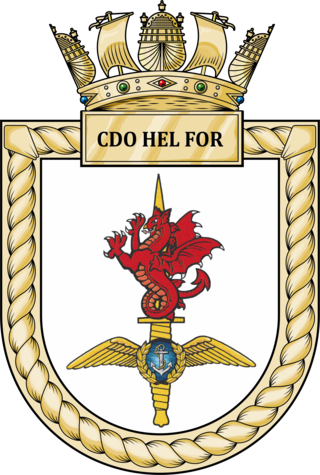
Commando Helicopter Force (CHF) is a unit of the Royal Navy Fleet Air Arm and an element of the Joint Aviation Command of the British Armed Forces. Its primary role is to provide Rotary-Wing support to 3 Commando Brigade Royal Marines and other UK force elements in the amphibious environment. CHF uses a combination of transport helicopters based at Royal Naval Air Station Yeovilton in Somerset, England.
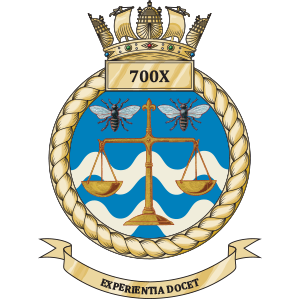
700 Naval Air Squadron is an experimental test squadron in the Royal Navy’s Fleet Air Arm.
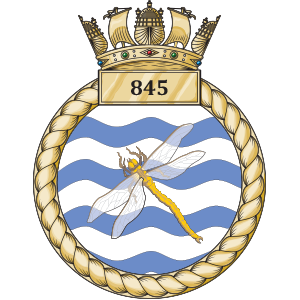
845 Naval Air Squadron is a squadron of the Royal Navy's Fleet Air Arm. Part of the Commando Helicopter Force, it is a specialist amphibious unit operating the AgustaWestland Commando Merlin HC4 helicopter and provides troop transport and load lifting support to 3 Commando Brigade Royal Marines. In 2012, the squadron celebrated 50 years since it was awarded "commando" status.
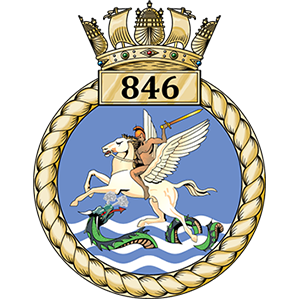
846 Naval Air Squadron is a squadron of the Royal Navy's Fleet Air Arm.

848 Naval Air Squadron was a squadron of the Royal Navy Fleet Air Arm. It operated the Westland Sea King HC.4 helicopter and previously provided advanced flying training to pilots for the other squadrons in the Commando Helicopter Force. The squadron was based at RNAS Yeovilton in Somerset and was decommissioned on 24 March 2016.

702 Naval Air Squadron was a Naval Air Squadron of the Royal Navy's Fleet Air Arm which last disbanded in August 2014. It was last based at HMS Heron, RNAS Yeovilton, Somerset and earlier at HMS Osprey, RNAS Portland, Dorset. As a training squadron it trained all ground and air crew for the sister front-line maritime Lynx unit, 815 Naval Air Squadron. It initially formed during July 1936 as a Catapult Flight for the 2nd Battle Squadron based at RAF Mount Batten and routinely embarking in RN ships such as, HMS Nelson, HMS Rodney and HMS Resolution. By 1939 it was known as 702 Naval Air Squadron but disbanded in January 1940.

815 Naval Air Squadron is a Royal Navy Fleet Air Arm squadron flying the AgustaWestland Wildcat HMA.2 helicopter and is the Navy's front line Wildcat Naval Air Squadron. The squadron is based at RNAS Yeovilton in Somerset. The squadron is capable of carrying out multiple roles such as: counter-narcotics, anti-piracy, Above Surface Warfare (ASuW), search and rescue, disaster relief and flying and engineering training. In the early 2000s, the Navy said that the squadron was largest helicopter squadron in Europe.
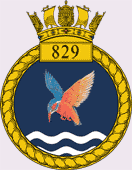
829 Naval Air Squadron was a squadron of the Royal Navy Fleet Air Arm. Before it was decommissioned in March 2018, it operated the AgustaWestland Merlin HM2 helicopter.
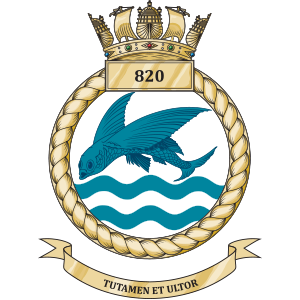
820 Naval Air Squadron is a Royal Navy Fleet Air Arm carrier-based squadron flying the AgustaWestland Merlin HM2 in Anti-Submarine and Airborne Early Warning (AEW) roles from RNAS Culdrose.
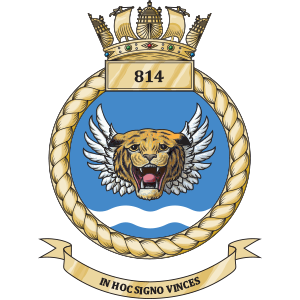
814 Naval Air Squadron or 814 NAS, nicknamed the Flying Tigers, is a squadron of the Royal Navy Fleet Air Arm. It is currently equipped with the AgustaWestland Merlin HM2 anti-submarine warfare helicopter and is based at Royal Naval Air Station (RNAS) Culdrose in Cornwall. The squadron was formed in December 1938 and has been disbanded and reformed several times.

824 Naval Air Squadron is a Royal Navy Fleet Air Arm squadron based at RNAS Culdrose and currently operating the AgustaWestland Merlin HM2 Operational Conversion Unit. It trains aircrew in Anti-Submarine warfare and Airborne Surveillance and Control.

3 Commando Brigade Air Squadron, Royal Marines, was formed in 1968 in Singapore by the amalgamation of three Commando Air Troops and the Brigade Flight. The squadron moved to Plymouth in 1971 and the two remaining UK Commando Air Troops became part of it. Apart from during the Falklands War, when the whole squadron was involved, it operated mostly on individual flight detachments. 3 Commando Brigade Air Squadron became 847 Naval Air Squadron in 1995.

707 Naval Air Squadron was a Naval Air Squadron of the Royal Navy's Fleet Air Arm which disbanded during February 1995. It was active during the Second World War forming during February 1945 as a Radar Trials Unit, disbanding in October of the same year. It reformed December 1964, as an Advanced and Operational Flying Training Commando helicopter squadron.

728C Naval Air Squadron was a Naval Air Squadron of the Royal Navy's Fleet Air Arm (FAA). It was active between January and October 1958 as the Amphibious Warfare Trials Unit. Equipped with four Westland Whirlwind HAS.22 helicopters, the squadron operated around the Mediterranean Basin before it was redesignated 848 Naval Air Squadron on achieving first line status.

772 Naval Air Squadron was a Naval Air Squadron of the Royal Navy's Fleet Air Arm which last disbanded during September 1995. 772 Naval Air Squadron formed as a Fleet Requirements Unit out of ‘Y’ Flight from 771 Naval Air Squadron at RNAS Lee-on-Solent in September 1939. While the headquarters remained there, floatplanes were operated out of RNAS Portland, however, mid 1940 saw the whole squadron move north to RNAS Campbeltown and roughly twelve months afterwards the short distance to RNAS Machrihanish. The unit moved to RNAS Ayr in July 1944 and became the Fleet Requirements Unit School. In January 1946 the squadron moved to RNAS Burscough in Lancashire, before moving to RNAS Anthorn in Cumberland, in May. It became the Northern Fleet Requirements Unit upon moving to RNAS Arbroath, in June 1947, but disbanded into 771 Naval Air Squadron in October. 772 Naval Air Squadron reformed as a Helicopter Support Squadron at RNAS Portland in September 1974. In September 1977 the squadron took over responsibility for a number of Ships' Flights of Royal Fleet Auxiliary ships. The squadron was used to reform 848 Naval Air Squadron for the Falklands Task Force in 1982, with the Ships' Flights absorbed into 847 Naval Air Squadron. In August 1982 it took on the Anti-Submarine Warfare Flight from 737 Naval Air Squadron and between 1983 - 1985 a Search and Rescue Flight operated out of RNAS Lee-on-Solent.
881 Naval Air Squadron was a squadron of the British Royal Navy's Fleet Air Arm formed in June 1941. It served as a fighter squadron in the Second World War, taking part in the British invasion of Madagascar in 1942, in the Allied invasions of Northern France and Southern France in 1944, also taking part in operations in the Aegean Sea and off Norway before disbanding in October 1945.

Wildcat Maritime Force (WMF) is a unit of the Royal Navy's Fleet Air Arm. Its primary role is to deploy the AgustaWestland Wildcat HMA2, a battlefield utility, search and rescue, aerial reconnaissance, anti-submarine warfare (ASW), anti-surface warfare (ASuW) and troop transport helicopter, to the frontline. Wildcat Maritime Force is formed of two squadrons, both based at Royal Naval Air Station Yeovilton in Somerset, England, 815 Naval Air Squadron for frontline operations and 825 Naval Air Squadron for engineer training and aircrew conversion.























